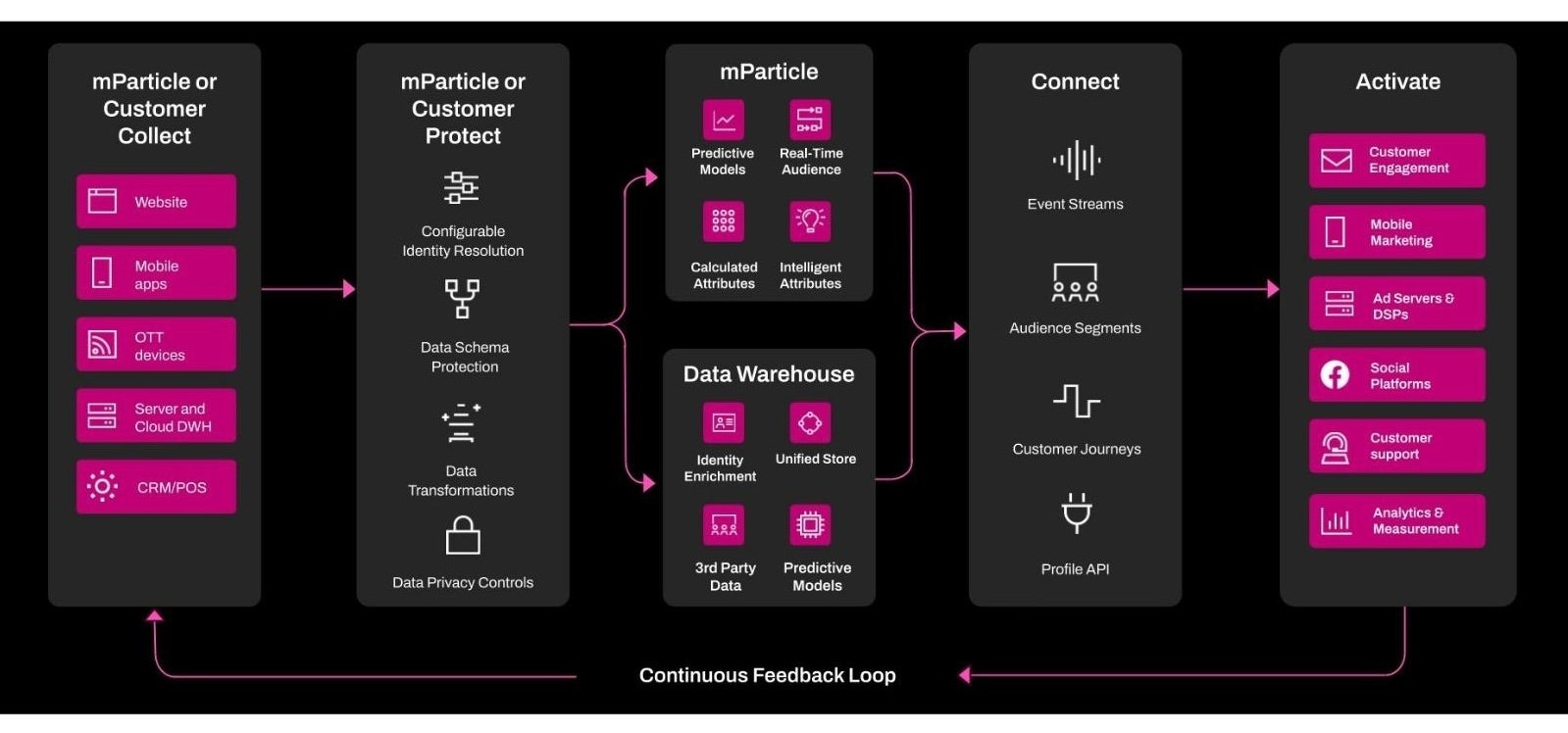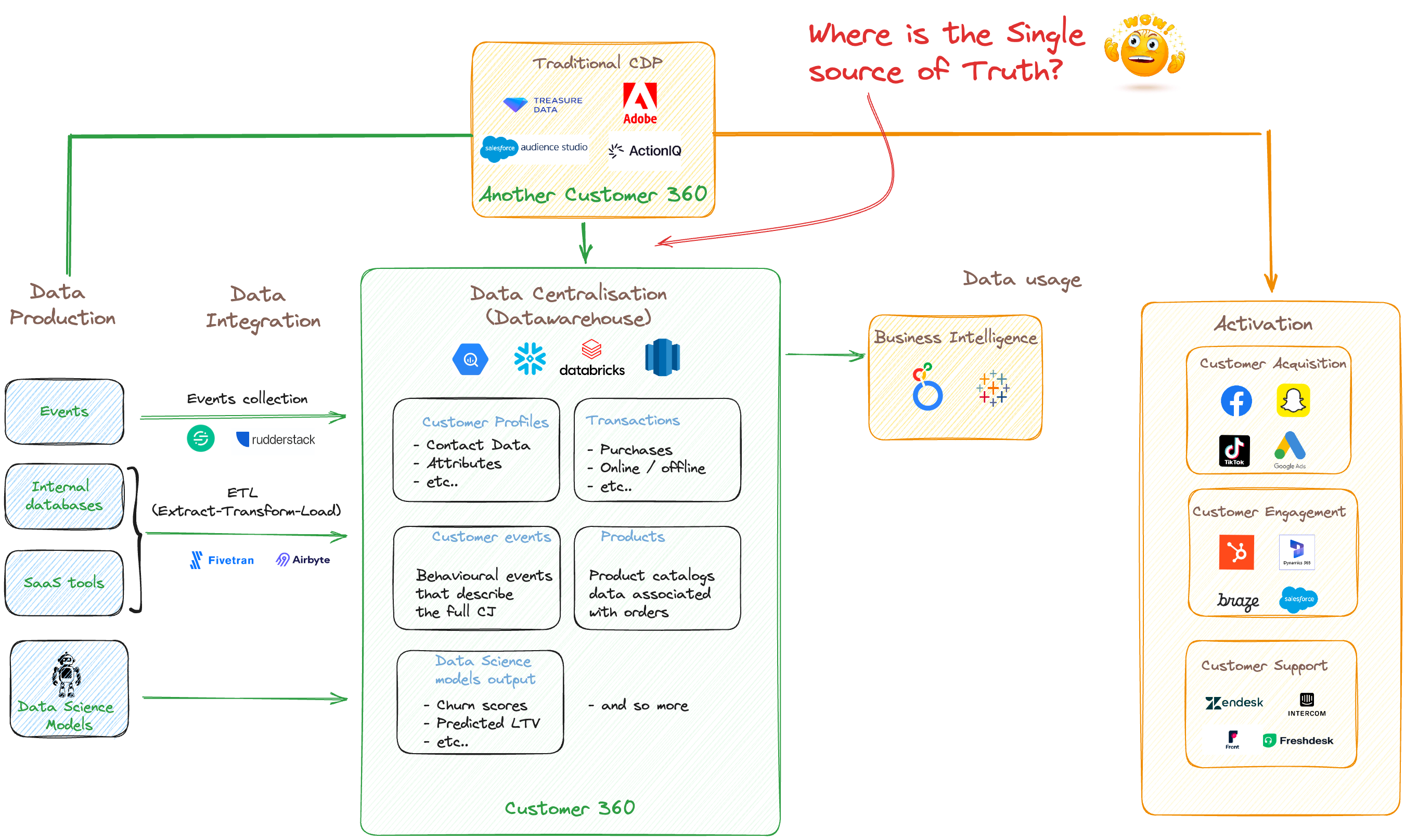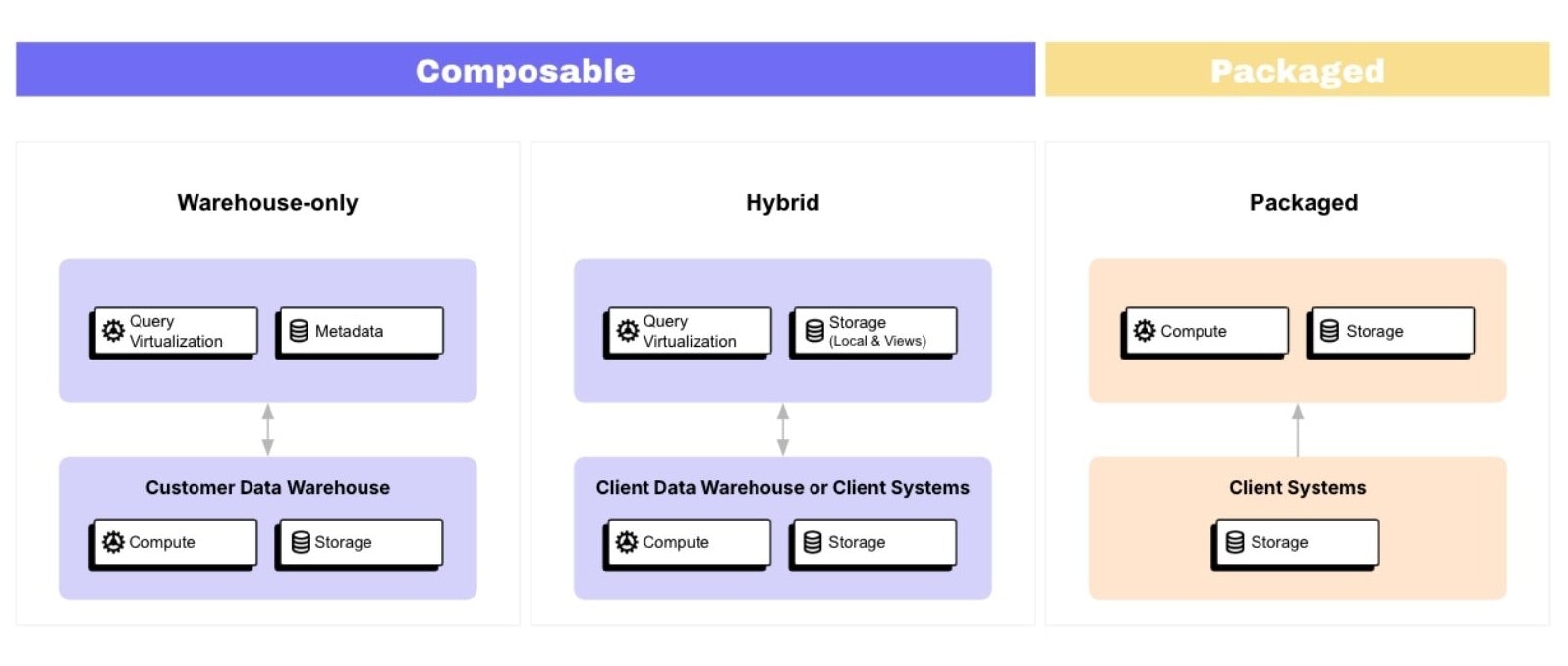
All about hybrid Customer Data Platforms (CDPs)
6min • Last updated on Nov 20, 2025

Olivier Renard
Content & SEO Manager
[👉 Summarise this article using ChatGPT, Google AI or Perplexity.]
Companies are collecting more and more data, while striving to reconcile marketing efficiency with robust technical infrastructure. Between packaged CDPs and composable CDPs, an intermediate model has emerged: the hybrid CDP.
Presented as a compromise offering the best of both worlds, it promises to combine performance with data control. But this architecture also raises important questions: where is the data actually stored, and what added value do hybrid solutions really offer compared to other CDPs on the market?
Key Takeaways:
A hybrid CDP combines the principles of a traditional packaged CDP and a warehouse-native composable CDP.
It aims to offer faster deployment and more flexibility to marketing teams.
In practice, these platforms remain more expensive and often retain a partial copy of the data, creating dual governance.
In contrast, a modular CDP imposes no vendor storage or proprietary model. It enables fast implementation and smooth data activation.
👉 What is a hybrid CDP and how does it differ from packaged or composable systems? Discover the advantages and limitations of this new type of platform. 🔍
What is a hybrid CDP?
A hybrid CDP is a type of Customer Data Platform with an architecture that sits between two models: the packaged CDP and the composable CDP.
It seeks to strike a balance between ease of use, rapid deployment and data control.
Packaged CDPs, also known as traditional CDPs, are pre-configured solutions. They collect, unify, and store customer data in their own database.
Everything is integrated according to a vendor-defined data model. This makes the system easy to use but comes at the cost of high vendor lock-in and data duplication within the vendor's infrastructure.
By contrast, composable or modular CDPs are part of the Modern Data Stack. They work directly with the company’s data warehouse (Snowflake, Google BigQuery, Databricks…).
No duplication or fixed schema: processing happens where the data already resides. This simplifies governance and fits naturally with existing tools.
The hybrid CDP therefore attempts to combine the best of both worlds: the flexibility of a composable CDP with the convenience of an integrated platform. It connects to the cloud data warehouse (CDW) to access customer data, while still maintaining an internal storage layer where some profiles and attributes are replicated.
In practice, this mixed data storage architecture creates a dual infrastructure. Data is selected from the warehouse, transformed into the vendor's model, then reintegrated into their database for segmentation or activation.
This complex process creates a second source of truth, in parallel with the data warehouse.
💡 Leading hybrid CDP vendors include Treasure Data, Simon Data, ActionIQ, and mParticle.

Example of hybrid architecture (Credit: mParticle)
Why do some vendors use the term “no-copy”?
The term "no-copy" is often used by hybrid CDP vendors to reassure clients about data handling. It simply means the entire warehouse isn’t duplicated.
In practice, however, partial duplication still occurs: profiles and attributes are copied into the CDP’s database for usage. This introduces more complex governance and latency from batch synchronisation.
Only a warehouse-native composable CDP ensures true zero-copy, since all data and processing remain entirely within the client’s own data warehouse.
Hybrid CDP vs Composable CDP: what’s the difference?
Both models share the same goal: to centralise, unify, and activate customer data. But they differ in architecture and operation.
One seeks the benefits of an all-in-one platform, while the other relies on the Modern Data Stack for a fully warehouse-native approach.
Criteria | Composable CDP (warehouse-native) | Hybrid CDP | Packaged CDP (traditional) |
|---|---|---|---|
Storage | No data copied | Partial duplication | Data stored and managed by the vendor |
Data model | Free model, direct CDW access | Proprietary schema | Closed and inflexible proprietary model |
Source of truth | Single (CDW) | Dual (CDP + CDW) | Dual (CDP + CDW) |
Performance | Native calculations in CDW | Batch processing, caching, latency | Batch processing, caching, latency |
Security & GDPR | Minimal exposure | Dual governance, broader scope | Vendor-hosted data, high dependency |
Scalability | Instant and frictionless | Needs adjustment for each evolution | Complex and costly to evolve (fixed layout, limited customisation) |
Costs | CDW only | CDW + vendor storage | Double storage + long integration |
Time-to-value | Immediate deployment | Slower integration | Deployment over several months |
Composable vs Hybrid vs Traditional CDP
How to interpret these differences?
Hybrid CDPs may suit companies that are less mature in terms of data or who want a turnkey solution. However, they involve dual data management, more latency, and added costs due to vendor storage.
Composable CDPs, on the other hand, are designed for data-driven organisations seeking to align BI and marketing in a unified environment. With no duplication, they offer consistency, simplified governance, and faster execution.

Traditional CDPs duplicate data, negating the concept of "Single Source of Truth"
Promises and limitations of hybrid CDPs
Key benefits claimed by vendors
Simplified deployment: faster integration with existing systems.
Turnkey marketing interface: audience creation, segmentation, and activation in one place.
Real-time activation: instant data processing for personalisation, fraud detection, or behavioural triggers.
Partial data warehouse integration (Snowflake, Redshift, BigQuery) to enrich or sync some attributes.
Observed technical limitations
Proprietary data model remains in place, limiting flexibility.
Data reintegration is required for activation despite “no-copy” claims, leading to latency.
Increased maintenance and hidden costs: managing both warehouse pipelines and internal CDP jobs.
Risk of divergence between BI data and what’s actually used in marketing campaigns.
How to choose?
Choosing a Customer Data Platform depends primarily on your company’s data maturity and strategic priorities. Organisations without a cloud data warehouse may be more comfortable with a hybrid or integrated solution.
By contrast, businesses equipped with a Modern Data Stack prefer a composable CDP. It builds on their existing infrastructure while ensuring complete control over data.
Main criteria to consider:
Maturity of data architecture (is there a CDW like Snowflake, BigQuery, Databricks, or Redshift?),
Governance and compliance requirements (GDPR, security, traceability),
Desired level of autonomy for both business teams (marketing, sales, product) and data teams.
💡 In general, composable CDPs offer agility, compliance, and scalability. If your company does not yet have a cloud data warehouse, explore our resources on data hosting.

CDP and data hosting
Advantages of the composable approach
An architecture centred on the data warehouse
A composable CDP relies on your existing data infrastructure: your warehouse is your single source of truth. Your data never leaves this environment: no duplication, no imposed schema.
This direct access ensures full alignment between analytics and marketing activation. The architecture is naturally scalable: every new data point added to the warehouse is instantly available for segmentation and activation.
Tangible benefits for teams
Time savings for IT: no more complex pipelines, manual queries, or multiple data copies.
Stronger collaboration between marketing and data: shared language, shared definitions, greater autonomy.
Compliance and security: data stays with the client, easing regulatory obligations (GDPR, CCPA, etc.).
Real-time omnichannel enablement: segments update instantly across all channels, with no latency or technical bottlenecks.
With DinMo, all generated data is activated directly from your data warehouse, following a zero-copy by design approach.
Conclusion
Companies today want to balance data control, ease of use, and marketing performance. The hybrid CDP was born from this desire for compromise, promising the “best of both worlds.”
However, its architecture results in a dual infrastructure, often introducing latency, additional costs, and potential mismatches between BI and marketing activation.
Data-driven organisations now prefer unified architectures centred on the data warehouse. This model ensures performance, transparency, compliance, and consistency.
This is the approach we promote at DinMo: a truly no-copy CDP, connected to your data warehouse, with no imposed schema and no third-party storage. A no-code, privacy-by-design platform that empowers marketing teams and accelerates data transformation for businesses.
👉 Discover how DinMo unifies your customer data and activates your audiences directly from your data warehouse — with zero duplication and zero friction. Contact us!





















